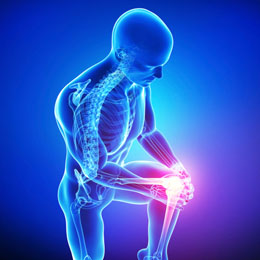Pseudogout is a joint disease involving severe pain and inflammation in different joints of the body, such as knee, shoulder, hip, and other large joints. It is often misdiagnosed as gout, rheumatoid arthritis, and osteoarthritis.

Pseudogout, a type of joint disease is characterized by the inflammation of the joints. The deposition of calcium pyrophosphate dihydrate crystals, in and around the joints causes the inflammation and results into pseudogout. Pseudogout is also referred to as pyrophosphate arthropathy. The meaning of the term 'pseudogout' is false gout. This is because it resembles gout in many ways; for example both the diseases involve crystal formation in the joints and both can lead to arthritis.
However, the difference between the two lies in the type of crystals formed. Gout involves the formation of monosodium urate crystals, while pseudo gout involves the formation of calcium pyrophosphate dihydrate crystals. There are reports that pseudogout and gout coexist with each other, wherein, both types of crystals are present in the joint fluid. It affects men and women equally, and is seen to commonly affect the older people. About 50% of people above the age of 85, are seen to be affected by this condition.
What Causes Pseudogout?
Collection of calcium pyrophosphate dihydrate crystals (CPPD) in the fluid around the joints, and subsequent formation of CPPD crystals in the joints results in the inflammation of the joints. Knees, wrists, ankles, and other joints swell and ache severely. Exactly why these CPPD crystals are formed is still not known. However, some believe that during old age, the synovial fluid around the joints become more susceptible to CPPD crystal growth.
Pseudogout is even speculated to be hereditary. People suffering from other diseases such as hyperparathyroidism, hemochromatosis, and hypomagnesemia may develop pseudogout. However, it has been observed that most people with this disease do not suffer from any of the above-mentioned conditions. Even though this disease mostly affects the elderly, it is also seen to affect young people suffering from diseases such as Wilson disease, thyroid disease, ochronosis, acromegaly, hemochromatosis, or parathyroid disease.
Symptoms of Pseudogout
The symptoms vary from person to person. Some people are seen to be afflicted by painful joint inflammation, mostly in wrists, knees, hips, and other major joints, while others may exhibit stiffness and lingering chronic pain in the arms and legs. Sometimes, pseudogout attacks may cause fever. Then, there are people who have no pain between attacks and people who have no pain at any time even with large deposits of crystals. Often pseudogout is misdiagnosed as gout arthritis, osteoarthritis, and rheumatoid arthritis due to the similarity of symptoms.
Just like gout, a pseudogout patient also suffers from severe joint pain, due to red and inflamed joints. However, it generally starts off in one joint and then gradually inflammation occurs in multiple joints. Also, pseudogout affects the larger joints (shoulder, knees, wrists, and hip), whereas gout affects the smaller joints. Further, the joints affected by pseudogout are the ones with calcified articular cartilage (chondrocalcinosis). This cartilage calcification is not seen in gout. The CPPD crystals formed in pseudogout are round, whereas monosodium urate crystals in gout are needle or spindle-shaped.
How to Treat Pseudogout?
Ice packs are applied to reduce pain and inflammation. High doses of colchicine, a medication commonly used in gout, is prescribed for inhibiting the migration of cells called granulocytes. Granulocytes are white blood cells that are responsible for initiating inflammation in the joints. Non-steroidal anti-inflammatory drugs (NSAID) such as indomethacin are used to reduce pain and inflammation. Low doses of NSAIDs are given to prevent the flare up of pseudogout. Aspiration of synovial fluid in the affected joints is another treatment option that is seen to shorten the attack duration. To relieve the joints of acute inflammation, corticosteroids are sometimes injected directly. At present there is no treatment or therapy available to remove the CPPD crystals from the joints. However, research regarding the surgical removal of calcifications is underway.
Although treatment stops acute attacks, it cannot undo the damage already caused to the joints. Even though there is no specific long-term treatment available for pseudogout, one can undergo physical therapy for muscle-strengthening. Range-of-motion exercises helps maintain the functioning of the joints.


 Pseudogout, a type of joint disease is characterized by the inflammation of the joints. The deposition of calcium pyrophosphate dihydrate crystals, in and around the joints causes the inflammation and results into pseudogout. Pseudogout is also referred to as pyrophosphate arthropathy. The meaning of the term 'pseudogout' is false gout. This is because it resembles gout in many ways; for example both the diseases involve crystal formation in the joints and both can lead to arthritis.
Pseudogout, a type of joint disease is characterized by the inflammation of the joints. The deposition of calcium pyrophosphate dihydrate crystals, in and around the joints causes the inflammation and results into pseudogout. Pseudogout is also referred to as pyrophosphate arthropathy. The meaning of the term 'pseudogout' is false gout. This is because it resembles gout in many ways; for example both the diseases involve crystal formation in the joints and both can lead to arthritis.